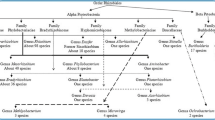Abstract
The family Leguminosae is one of the largest families of flowering plants, including more than 18,000 species (Young, Johnston, 1989). Their symbiotic bacterial partners are very diverse and do not form a discrete clade. Although they are collectively referred to as rhizobia, they are now classified in distinct Rhizobium, Bradyrhizobium, Azorhizobium and Sinorhizobium (Young, Haukka, 1996). Some rhizobia are indeed more closely related to nonsymbiotic bacteria than they are to other rhizobia. However, all rhizobial species possess common nodulation (nod) genes, the nodABC genes, and consequently produce nodulation signals, the Nod factors, that belong to the same chemical family: they are chitin oligomers of 4 or 5 glucosamine residues that are mono-N-acylated at the terminal non-reducing end. The common chitin oligomer core can be substituted at both ends of the molecule, and each rhizobial species or biovar produces a set of major Nod factors with characteristic substitutions (Dénarié et al., 1996). These substitutions are under the control of specific nod genes. In the case of Sinorhizobium meliloti, it has been shown that the three substitutions are essential for effective infection of the host plant, alfalfa. The structure of major Nod factors has now been determined for most rhizobial species and their comparison indicates that Nod factor structure is related to rhizobial host range (Dénarié et al., 1996).
Access this chapter
Tax calculation will be finalised at checkout
Purchases are for personal use only
Preview
Unable to display preview. Download preview PDF.
Similar content being viewed by others
References
Ardourel M et al. (1994) Plant Cell 6, 1357–1374.
Chen WX et al. (1991) Int. J. Syst. Bacteriol. 41, 275–280.
Crisp MD, Doyle JJ (1995) Advances in Legume systematics. Part 7 Phylogeny. The Royal Botanic Gardens, Kew, United kingdom.
Demont N et al. (1993) J Biol Chem. 268, 20134–20142.
Dénarié J et al. (1996). Annu. Rev. Biochem. 65, 503–535.
Legocki A et al. (1997) In Legocki A, Bothe H and Pühler A, eds, Biological Nitrogen Fixation for Ecology and Sustainable Agriculture, pp 263–266, Springer-Verlag Berlin-Heidelberg.
Lerouge P et al. (1990) Nature 344, 781–784.
Lindström K (1989) Int. J. Syst. Bacteriol. 39, 365–367.
Lopez-Lara IM et al. (1995) Mol. Microbiol. 15, 627–638.
Räsänen et al. (1991) Mol. Plant-Microbe Interact. 6, 535–544.
Ritsema T et al. (1996) Mol Gen Genet. 251, 44–51.
Roche P et al. (1996) Proc Natl Acad Sci USA 93, 15305–15310.
Schultze M et al. (1992) Proc Natl Acad Sci USA 89, 192–196.
Spaink HP et al. (1991) Nature 354, 125–130.
van der Drift KMGM (1996) J Biol Chem 271, 22563–22569.
Young JPW and Johnston AWB (1989) Trends Ecol. Evol. 4, 341–349.
Young JPW and Haukka KE (1996) New Phytol. 133, 87–94.
Author information
Authors and Affiliations
Editor information
Editors and Affiliations
Rights and permissions
Copyright information
© 1998 Springer Science+Business Media Dordrecht
About this chapter
Cite this chapter
Yang, G.P. et al. (1998). Rhizobium Nod Factor Structure and the Phylogeny of Temperate Legumes. In: Elmerich, C., Kondorosi, A., Newton, W.E. (eds) Biological Nitrogen Fixation for the 21st Century. Current Plant Science and Biotechnology in Agriculture, vol 31. Springer, Dordrecht. https://doi.org/10.1007/978-94-011-5159-7_86
Download citation
DOI: https://doi.org/10.1007/978-94-011-5159-7_86
Publisher Name: Springer, Dordrecht
Print ISBN: 978-94-010-6169-8
Online ISBN: 978-94-011-5159-7
eBook Packages: Springer Book Archive




